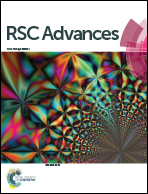Adsorption of potentially toxic metals on negatively charged liposomes: equilibrium isotherms and quantitative modeling†
Abstract
We investigated the adsorption behaviour of ten potentially toxic metals (Ni, Co, Cd, Fe, Ba, Sr, Cr, Hg, Ag and Zn) on negatively charged liposome vesicles composed of phosphatidyl choline (PC), phosphatidyl glycerol (PG) and cholesterol. The adsorption data for selected metal ions closely fit the Freundlich isotherm. Most metal ions (except Cr3+ and Cd2+) were strongly adsorbed by liposomes (n > 1) and the ionic covalent index significantly affected the Freundlich adsorption intensity. We used multivariate statistical methods, including principal components analysis regression and partial least squares regression, to elucidate the adsorption relationships between 18 physical and chemical properties and their respective Freundlich isotherm constants (KF). The cross-validated correlation efficient (Qcum2) and correlation coefficient (RY2) of the model were 0.76 and 0.91, respectively. High Qcum2 and RY2 values indicated that the predictive model was both precise and robust. According to the VIP value, parameters like ionic polarisation, ion charge and ionisation potential played crucial roles in predicting KF.


 Please wait while we load your content...
Please wait while we load your content...